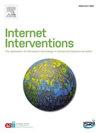Feasibility, acceptability and preliminary clinical outcomes of a brief coping-focused intervention for delusions blended with smartphone-based ecological momentary assessment and intervention in persons with schizophrenia spectrum disorders: A pilot single-arm trial
IF 4.1
2区 医学
Q1 HEALTH CARE SCIENCES & SERVICES
Internet Interventions-The Application of Information Technology in Mental and Behavioural Health
Pub Date : 2025-01-27
DOI:10.1016/j.invent.2025.100804
引用次数: 0
Abstract
Delusions are one of the core symptoms of schizophrenia spectrum disorders (SSD), associated with distress and impaired functioning. Traditional Cognitive Behavioral Therapy (CBT) approaches are less effective for delusions, require significant resources, and specialized staff training. Symptom-specific therapy approaches, which target factors involved in the development and maintenance of psychotic symptoms, provide a valid alternative. Recent research demonstrates the efficacy of coping strategies as an intervention element, however, so far, only in the context of auditory hallucinations. Digital technologies, such as ecological momentary assessment (EMA) and ecological momentary intervention (EMI), are gaining attention in mental health, providing enhanced assessment and intervention opportunities. The present single-arm trial aimed to investigate the feasibility, acceptability, and preliminary outcomes of a smartphone-based blended EMA/I psychological therapy approach focusing on improving coping strategies for delusions in SSD. In total, N = 10 participants received four face-to-face therapy sessions alongside German university-level treatment-as-usual over an intervention period of four to six weeks. Feasibility was assessed by completion rates of the EMA/I questionnaires, use of the application between sessions and recruitment rates. Acceptability was assessed by a satisfaction questionnaire, open feedback, and analysis of adverse effects. Clinical outcomes included self-rated and rater-based intensity and distress of delusions and comorbid symptoms at pre- and post-intervention. Findings supported the feasibility and acceptability of the DICE (DICE - Delusion Ideation in the Context of Everyday life intervention) intervention, with high retention (10/13 participants, 77 %) and completion rates for the EMA- (59 %) and EMI-questionnaires (72 %), as well as a high protocol adherence (90–97 %), exceeding all predefined benchmarks. Open feedback indicated good satisfaction, with all participants using the application between sessions, reflecting a high engagement level. Clinical outcomes displayed relevant changes in ameliorating the intensity of delusions when being measured by the Psychotic Symptom Rating Scales as well as by the Green Paranoid Thought Scale, and self-rated improvements in distress and depressive symptoms. Changes in the intensity and distress of delusions might be explained by improved coping behaviour. Further research with control conditions is needed to validate findings and analyze the efficacy as well as mechanisms of actions of the intervention in a fully powered trial.
以应对为重点的妄想干预与基于智能手机的生态瞬时评估和干预在精神分裂症谱系障碍患者中的可行性、可接受性和初步临床结果:一项单臂试验
妄想是精神分裂症谱系障碍(SSD)的核心症状之一,与痛苦和功能受损有关。传统的认知行为疗法(CBT)治疗妄想的效果较差,需要大量的资源和专门的人员培训。症状特异性治疗方法,其目标因素涉及的发展和维持精神病症状,提供了一个有效的选择。最近的研究表明,应对策略作为一种干预因素的有效性,然而,到目前为止,仅在幻听的背景下。数字技术,如生态瞬间评估(EMA)和生态瞬间干预(EMI),在心理健康领域越来越受到关注,提供了更好的评估和干预机会。本单臂试验旨在探讨基于智能手机的混合EMA/I心理治疗方法的可行性、可接受性和初步结果,该方法侧重于改善SSD妄想的应对策略。总共有N = 10名参与者在4到6周的干预期内接受了4次面对面的治疗,同时接受了德国大学水平的常规治疗。可行性通过EMA/I问卷的完成率、会议之间应用程序的使用和招聘率来评估。通过满意度问卷、公开反馈和不良反应分析来评估可接受性。临床结果包括干预前和干预后自评和基于评分的妄想和共病症状的强度和痛苦。研究结果支持DICE (DICE -日常生活干预背景下的妄想妄想)干预的可行性和可接受性,具有高保留率(10/13名参与者,77%)和EMA-(59%)和emi -问卷(72%)的完成率,以及高协议依从性(90 - 97%),超过所有预定义的基准。公开反馈显示出良好的满意度,所有参与者在会议间隙都使用应用程序,反映出高参与度。临床结果显示,在精神病症状评定量表和绿色偏执思维量表测量时,妄想强度的改善有相关的变化,在痛苦和抑郁症状的自评改善方面也有相关的变化。妄想的强度和痛苦程度的变化可以用改善的应对行为来解释。需要在控制条件下进行进一步的研究,以验证研究结果,并在全动力试验中分析干预措施的疗效和作用机制。
本文章由计算机程序翻译,如有差异,请以英文原文为准。
求助全文
约1分钟内获得全文
求助全文
来源期刊

Internet Interventions-The Application of Information Technology in Mental and Behavioural Health
Medicine-Health Informatics
CiteScore
6.50
自引率
9.30%
发文量
94
审稿时长
6 weeks
期刊介绍:
Official Journal of the European Society for Research on Internet Interventions (ESRII) and the International Society for Research on Internet Interventions (ISRII).
The aim of Internet Interventions is to publish scientific, peer-reviewed, high-impact research on Internet interventions and related areas.
Internet Interventions welcomes papers on the following subjects:
• Intervention studies targeting the promotion of mental health and featuring the Internet and/or technologies using the Internet as an underlying technology, e.g. computers, smartphone devices, tablets, sensors
• Implementation and dissemination of Internet interventions
• Integration of Internet interventions into existing systems of care
• Descriptions of development and deployment infrastructures
• Internet intervention methodology and theory papers
• Internet-based epidemiology
• Descriptions of new Internet-based technologies and experiments with clinical applications
• Economics of internet interventions (cost-effectiveness)
• Health care policy and Internet interventions
• The role of culture in Internet intervention
• Internet psychometrics
• Ethical issues pertaining to Internet interventions and measurements
• Human-computer interaction and usability research with clinical implications
• Systematic reviews and meta-analysis on Internet interventions
 求助内容:
求助内容: 应助结果提醒方式:
应助结果提醒方式:


